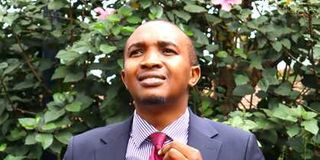
Lawyer and activist Morara Kebaso during an interview at Fairmont The Norfolk Hotel in Nairobi on August 22, 2024.
A writer (artist) looking for subjects inquires not after what he loves best, but after what he alone loves at all. Strange seizures beset us.
Frank Conroy loves his yo-yo tricks, Emily Dickinson her slant of light; Richard Selzer loves the glistening peritoneum, Faulkner the muddy… little girl’s drawers visible when she’s up a pear tree… Why do you never find anything written about that idiosyncratic thought you advert to, about your fascination with something no one else understands?
Because it is up to you. There is something you find interesting, for a reason hard to explain.
It is hard to explain because you have never read it on any page; there you begin. You were made and set here to give voice to this, your own astonishment,” so wrote American writer Annie Dillard on writing but it can apply to all forms of art and how an artist’s consciousness (political or otherwise) is formed.
This can especially apply to Morara Kebaso, the lawyer-turned-activist who is using the art of parody to draw attention to the projects President William Ruto launched but have seemingly stalled. Morara’s style is what Dillard would characterise as “strange seizures” that beset artists and a “fascination with something no one understands”.
Morara is probably channelling a nameless burden, giving voice to his “astonishment” that doesn’t bother other people. In this sense, artists are like prophets — burdened by something they can’t keep quiet about.
The biblical Prophet Jeremiah used an allegory of something that was like “fire shut up in his bones”. As for Morara, he has been “seized” by a desire to use parody as an art form to tackle real-life issues by holding political leaders and government officials to account for broken promises.
He is also drawing attention to stalled projects and wastage of public funds in projects that keep getting launched and relaunched. This is the raw material for his art.
Parody as an art form has been defined as “a humorous or mocking imitation of something, using the same form as the original”. In this case, Morara is mimicking (making a parody of) President William Ruto, from the ubiquitous Kaunda suits to the president’s voice and mannerisms atop his choice vehicle as he makes (more) promises to Kenyans. Morara has reportedly announced a countrywide “inspection tour” of government projects.
In a way, Morara reminds one of the famous play, ‘The Government Inspector,’ by the Ukraine-born Russian writer Nikolai Gogol. The play is set in a small town in Russia, in the 1830s.
Government inspector
It starts with a meeting between the governor and the town’s foremost officials — the superintendent of schools, the judge, the director of charities, the town doctor, and a local police officer — to inform them that a government inspector is due to arrive from Saint Petersburg, then the capital of Tsarist Russia.
The governor explained that the government inspector was to arrive “incognito” so wouldn’t be identified and that he would also have “secret instructions” to inspect how things were conducted in the administration of the town. Everyone panics and the governor encourages officials to cover up any unethical practices.
What Morara is doing has some uncanny parallels with what happens in The Government Inspector. First, both Morara and The Government Inspector hold a mirror to us.
Some people are unhappy with Morara but it’s like getting angry with a mirror for showing how one truly looks.
Morara has been reportedly threatened but that’s like threatening to break a mirror. In The Government Inspector, there is an epigraph (a short quotation at the beginning of the play) that’s taken from a Russian proverb and reads: “If your face is lopsided, don’t blame the mirror.” Morara is holding a mirror to the government.
He recently said, “Take note this is a campaign against bad governance. We will also talk about citizen mob audit and accountability.”
Another way that Morara is like the character (Khlestakov) in The Government Inspector is that both are amusing young men. They use humour to pass a strong message. As for Morara, he mimics the president, and people can laugh but the message is home.
Morara’s is laughter with sadness just like in The Government Inspector. In describing Gogol’s works, the great Russian writer, Aleksandr Pushkin, said that “behind his laughter you feel the sad tears.”
This is true of Morara’s parody.
Even if we laugh at his theatrics, our hearts are crying because of the bitter truths he is exposing. Towards the end of The Government Inspector, the governor turns to the audience, asking: “What are you laughing at? You are laughing at yourselves.” As we laugh at Morara’s parody, in a way, we are laughing at ourselves.
Morara is our own kind of “Government Inspector”, quickly becoming a civic education champion as he puts government in check.
After listening to Morara reminding us of all the stalled projects, one is left thinking about the Kenyans that would have benefitted had those projects been completed, what those Kenyans dreamt about as they voted into power the politicians who promised heaven, what those Kenyans longed for and how it was all destroyed by corruption. It’s a heartbreaking and sad, sad situation.
The writer is a book publisher based in Nairobi. [email protected]







